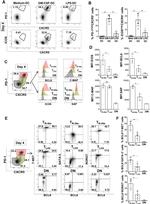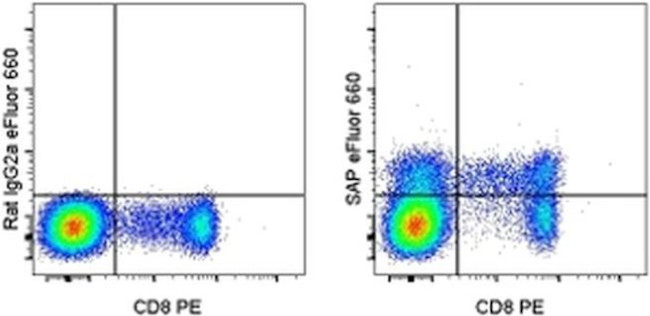Search Thermo Fisher Scientific
Invitrogen
SAP (SLAM-Associated Protein) Monoclonal Antibody (XLP-1D12), eFluor™ 660, eBioscience™
FIGURE: 1 / 2
SAP (SLAM-Associated Protein) Antibody (50-9787-42) in Flow


Product Details
50-9787-42
Species Reactivity
Published species
Host/Isotype
Recommended Isotype Control
Class
Type
Clone
Conjugate
Excitation/Emission Max
Form
Concentration
Purification
Storage buffer
Contains
Storage conditions
Shipping conditions
RRID
Product Specific Information
Description: The monoclonal antibody XLP-1D12 reacts with human SLAM-associated protein (SAP), which is also known as SH2D1A. SAP is a 15-kDa SH2 domain-containing adaptor protein. Upon CD150/SLAM family receptor ligation, SAP recruits Fyn tyrosine kinase, which phosphorylates the receptor to activate downstream signaling events. SAP is expressed in thymocytes, T cells, NK cells, and NKT cells. Studies have demonstrated a role for SAP in promoting follicular T helper cell differentiation during germinal center formation. In addition, this protein is involved in NKT cell development, Th1/Th2 differentiation, development of innate T cells, and regulation of NK cell and CD8+ T cell cytotoxicity. Mutations of the gene encoding SAP results in X-linked lymphoproliferative (XLP) syndrome, which is characterized by impaired humoral immunity leading to increased susceptibility to Epstein-Barr virus infection and/or lymphoma. SAP has also been linked to automimmune diseases such as systemic lupus erythematosus.
Applications Reported: This XLP-1D12 antibody has been reported for use in intracellular staining followed by flow cytometric analysis.
Applications Tested: This XLP-1D12 antibody has been pre-titrated and tested by intracellular staining and flow cytometric analysis of normal human peripheral blood cells using the Foxp3/Transicription Factor Staining Buffer Set (Product # 00-5523-00) and protocol. Please refer to Best Protocols: Protocol B: One step protocol for (nuclear) intracellular proteins located under the Resources tab online. This can be used at 5 µL (0.03 µg) per test. A test is defined as the amount (µg) of antibody that will stain a cell sample in a final volume of 100 µL. Cell number should be determined empirically but can range from 10^5 to 10^8 cells/test.
eFluor® 660 is a replacement for Alexa Fluor® 647. eFluor® 660 emits at 659 nm and is excited with the red laser (633 nm). Please make sure that your instrument is capable of detecting this fluorochome.
Excitation: 633-647 nm; Emission: 668 nm; Laser: Red Laser.
Filtration: 0.2 µm post-manufacturing filtered.
Target Information
This gene encodes a protein that plays a major role in the bidirectional stimulation of T and B cells. This protein contains an SH2 domain and a short tail. It associates with the signaling lymphocyte-activation molecule, thereby acting as an inhibitor of this transmembrane protein by blocking the recruitment of the SH2-domain-containing signal-transduction molecule SHP-2 to its docking site. This protein can also bind to other related surface molecules that are expressed on activated T, B and NK cells, thereby modifying signal transduction pathways in these cells. Mutations in this gene cause lymphoproliferative syndrome X-linked type 1 or Duncan disease, a rare immunodeficiency characterized by extreme susceptibility to infection with Epstein-Barr virus, with symptoms including severe mononucleosis and malignant lymphoma. Multiple transcript variants encoding different isoforms have been found for this gene.
For Research Use Only. Not for use in diagnostic procedures. Not for resale without express authorization.
How to use the Panel Builder
Watch the video to learn how to use the Invitrogen Flow Cytometry Panel Builder to build your next flow cytometry panel in 5 easy steps.
Bioinformatics
Protein Aliases: Duncan disease SH2-protein; Duncan's disease; FLJ18687; FLJ92177; HGNC:10820; RP5-1052M9.3; SH2 domain-containing protein 1A; signaling lymphocyte activation molecule-associated protein; Signaling lymphocytic activation molecule-associated protein; SLAM associated protein/SH2 domain protein 1A; SLAM-associated protein; T cell signal transduction molecule SAP; T-cell signal transduction molecule SAP
Gene Aliases: DSHP; EBVS; IMD5; LYP; MTCP1; SAP; SAP/SH2D1A; SH2D1A; XLP; XLPD; XLPD1
UniProt ID: (Human) O60880
Entrez Gene ID: (Human) 4068

Performance Guarantee
If an Invitrogen™ antibody doesn't perform as described on our website or datasheet,we'll replace the product at no cost to you, or provide you with a credit for a future purchase.*
Learn more
We're here to help
Get expert recommendations for common problems or connect directly with an on staff expert for technical assistance related to applications, equipment and general product use.
Contact tech support

